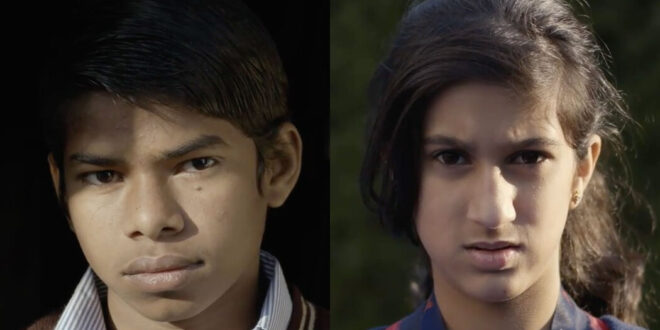Round 7 within the morning, Monu, 13, lifts his mosquito netting and crawls away from bed onto a dust flooring. Outdoors, his mom cooks breakfast over an open hearth.
A couple of miles throughout New Delhi, the world’s most polluted capital, 11-year-old Aamya lastly offers in to her mother’s coaxing. She climbs away from bed and treads down the corridor, previous an air air purifier that reveals the air pollution ranges in glowing numbers.
The air is comparatively clear in Aamya’s condo in Higher Kailash II, certainly one of Delhi’s upper-middle-class neighborhoods. Nicely-fitted doorways and home windows make the house extra hermetic, and its rooms purr with the sound of three purifiers that scrub harmful particles from the air.
Monu’s neighborhood
Aamya’s neighborhood
Monu breathes fouler air. He lives in a hut in a slum close to the Yamuna River, which itself is severely polluted. This morning, he sits within the open entryway to his home, consuming milky tea. He’s the seventh of 9 youngsters and watches as certainly one of his brothers coughs and huddles for heat close to the household’s wood-burning clay range.


Air air pollution killed more Indians final 12 months than every other threat issue, and Delhi is among the many most polluted cities within the nation. However the burden is unequally shared.
Kids from poor households in Delhi spend extra of their lives open air. Their households are extra doubtless to make use of wood-burning stoves, which create soot. They will’t afford the air filters which have turn into ubiquitous in middle-class properties. And sometimes, they don’t even suppose a lot about air air pollution, as a result of they face extra urgent threats, like operating out of meals.
Cash should buy a household much less publicity to Delhi’s lethal air pollution — however solely to some extent. Air purifiers and well-sealed rooms can do solely a lot. Although exact estimates are not possible, even well-off children like Aamya may lose roughly a 12 months of life due to the quantity of poisonous air they breathe. And Aamya has bronchial asthma, so her dad and mom are particularly involved.
Nonetheless, over the course of at some point, Monu was uncovered to about 4 instances as a lot air pollution as Aamya. An extended-term, constant disparity like that would steal around five years extra life from somebody in Monu’s place, in contrast with an upper-middle-class little one like Aamya.
We all know Monu was uncovered to extra air pollution, as a result of we measured it.
Working with researchers from ILK Labs, on Dec. three of final 12 months, journalists with The New York Occasions tracked how a lot air air pollution the 2 youngsters had been uncovered to over the course of a single day.
As Monu and Aamya went about an in any other case odd faculty day, we adopted them with cameras and air-quality displays that measured how a lot wonderful particulate matter was within the air they breathed at any given second. Generally known as PM2.5, these are tiny poisonous particles, particularly harmful as a result of they will infiltrate the bloodstream.
Monu and Aamya have by no means met, however their households learn about one another. Their dad and mom agreed to take part on this report after we defined what we may be taught by measuring the air pollution publicity of kids from totally different backgrounds. Aamya’s mom mentioned she hoped it might assist increase consciousness in regards to the better well being dangers confronted by households with fewer sources.
We may see the distinction within the high quality of the air they breathed, simply from the filters of their air pollution displays.


Images of the small filters that had been inside the kids’s air pollution displays.
The air pollution in Delhi has an nearly bodily presence.
You’ll be able to see it, a haze simply up the road. You’ll be able to scent it, like an acrid campfire, and you’ll style it in your tongue. It will possibly make your eyes burn, your throat itch and your head pound. The tiny particles floating within the air increase the risk of blood clots that may trigger coronary heart assaults. They will injury your liver and brain.
Among the particles are composed of very toxic supplies like arsenic and lead. Different elements could also be much less poisonous in and of themselves, however their cumulative impact is one other matter. With alarming regularity, researchers launch new findings on the numerous methods air air pollution harms the human physique.
Quickly after our reporting, the coronavirus pandemic struck.
Air pollution ranges plummeted this spring throughout India’s strict lockdown, producing a uncommon sight within the metropolis: pure blue skies. Sadly, this was quick lived. As soon as the lockdown lifted in summer time, the air pollution got here again. And now, as winter bears down, the air air pollution throughout India is as soon as once more hitting hazardous ranges.
Docs fear that the poisonous air is making the virus even deadlier. Publicity to excessive ranges of air pollution causes irritation of the airways, which makes individuals extra vulnerable to all types of infections.
“We’re seeing it occur in entrance of us,” mentioned Dr. Arvind Kumar, a chest surgeon and founding father of the Lung Care Basis in New Delhi. “Lots of people are coming to hospitals from the periphery areas the place inhabitants density and air pollution ranges are very excessive.”
It’s a reminder, if one had been wanted, that not everybody breathes the identical air.
“The wealthy can have the highest quality air purifiers,” Dr. Kumar mentioned. “The poor can’t.”
The air pollution hung grey within the air the morning we drove to Monu and Aamya’s properties. Authorities measurements put wonderful particulate matter at 130 micrograms per cubic meter — 5 instances worse than the World Well being Group says is safe. However locals mentioned it was day for air high quality. Comprehensible, because the most polluted day there final 12 months measured 4 instances worse.
Aamya and Monu began their morning commute via the smog.
Monu rode his bike to a free open-air faculty underneath a bridge, about 5 minutes from his home down a dusty highway. He likes bodily exercise, and he desires to be an officer within the Indian Military when he grows up.
Aamya likes sports activities, too, however she desires to be a musician. She rode to high school together with her mother within the air-conditioned cabin of the household Hyundai.
Monu’s faculty
Aamya’s faculty
Aamya attends a personal faculty, the Ardee Faculty, recognized for its efforts to insulate its college students from air air pollution. The varsity prices about $6,000 per 12 months.

Free faculty
underneath the bridge

Free faculty
underneath the bridge
The Ardee Faculty posts air pollution readings on its web site and on a board within the constructing that makes use of coloured flags to sign the air high quality. When it will get too dangerous, college students are required to put on masks. Only a few wore one whereas we had been there, as a result of it was not thought-about a foul day.
A big air filter within the basement of Aamya’s faculty
Monu’s faculty is free — but it surely has neither partitions nor doorways. For these college students, the skin air was the within air. Volunteer lecturers struggled to be heard as metro trains thundered overhead each 5 minutes.
All morning, whereas Monu was in school, vehicles and motorbikes whizzed previous on the road subsequent to his faculty, kicking up mud and clogging the air with exhaust fumes. Aamya’s faculty had air purifiers in each room, linked collectively via a telephone app that directors monitored continuously.
Each Monu and Aamya sound fatalistic.
“It can maintain rising,” Monu says. “If now we have 10 sick children at this time, it’ll be 20 tomorrow. A lot of individuals will get sick, and their dad and mom and docs will say that it’s due to the air pollution.”
Aamya thinks that the federal government is responsible, and that one individual can’t make a lot of a dent in the issue.
“There are numerous bushes, which aren’t serving to that a lot,” she says. “What my instructor says is that we will make a distinction. However I don’t consider in that, as a result of now we have tried loads.”
Within the afternoon, after lunch at house, Monu went to a different faculty, which he does each weekday. The outside air pollution ranges started to fall, as they do on most days when the morning visitors clears up and the winds shift.
There isn’t any single explanation for India’s air pollution drawback — and no single answer.
However Indians have realized to depend on one factor: Fall and winter are air pollution seasons. As air temperatures dip and wind speeds drop, pollution focus over India’s cities, particularly within the north, which lies within the shadow of the Himalayas. The mountain vary types a barrier that cuts down air motion even further.

Air pollution ranges throughout India
Micrograms of wonderful particulate matter
per cubic meter in 2016 | Supply: NASA

Air pollution ranges throughout India
Micrograms of wonderful particulate matter
per cubic meter in 2016 | Supply: NASA

Air pollution ranges in India
Micrograms of wonderful particulate matter per cubic meter in 2016 | Supply: NASA
The pollution themselves come from a number of sources.
By some estimates, automobile exhaust accounts for round 20 to 40 percent of the PM2.5 in New Delhi, which is infamous for its visitors. Family fires and industrial emissions additionally play a task. And because the climate cools within the fall, farmers in rural areas burn stays from their crops, sending up enormous clouds of black smoke that drift for miles and settle over the town.
The top result’s that the town’s smog is a number of the thickest on the planet.
India’s authorities has not made battling air pollution a precedence. Many officers see it as a value they’re keen to pay for fast financial development, which has lifted a whole lot of hundreds of thousands of individuals out of poverty.
Outrage shouldn’t be all the time simple to search out on the road, both, irrespective of how smog-shrouded. Environmental activists say most individuals do not know about how dangerous it truly is.
“We’re speaking about individuals who grew up in rural areas and so they come to the town with no preparation,” mentioned Ravina Kohli, a member of My Proper to Breathe, a nationwide clear air group. “Once they see polluted air, they don’t even suppose it’s polluted.”
There may be additionally little information on how socioeconomic disparities might worsen air pollution publicity in New Delhi, in keeping with Pallavi Pant, a employees scientist on the Well being Results Institute. “We aren’t placing a cautious sufficient lens on individuals’s occupation, or the place they stay, or what their socioeconomic standing is,” she mentioned.
Clearly, cash helps.
Aamya’s dad and mom, for instance, have managed to protect her from a number of the air pollution. However it isn’t practically sufficient.
The truth is, researchers say, there isn’t a quantity of private spending that may repair the issue. A lot broader actions must be taken, they are saying, to make India’s cities wholesome for everyone — wealthy or poor.
At day’s finish, an invisible enemy seeps via the doorways and home windows of wealthy and poor alike.
With faculty over, Aamya and Monu are again at their homes, settled in to do their homework.
When he’s completed, Monu watches his mother cook dinner over an open hearth, similar to he did within the morning. At Aamya’s house, a servant does the cooking in a separate room.
As Aamya’s household takes their seats on the dinner desk, the air purifiers proceed their reassuring hum. However there may be solely a lot the machines can do. In Delhi, the air is the air, and like most buildings within the metropolis, Aamya’s home is outmatched.
Monu’s mom, Ranju, by no means thinks about air air pollution, she says. When requested about it, she laughs, waving her hand dismissively and saying, “It’s the least of my worries.” Her day, in any case, is lengthy and arduous, starting at four a.m. and going till 10 at evening.
Monu’s household has no operating water, so it’s as much as Ranju to fetch the water on daily basis from a hand pump. She has 9 youngsters, and cooks and cleans for the household. She by no means went to high school.
Aamya’s mom, Bhavna, holds an M.B.A., labored for years as a advertising government and, as a youthful lady, lived in Paris. Air air pollution is a serious fear for her, particularly due to Aamya’s bronchial asthma.
“As youngsters, our dad and mom used to inform us ‘You should be extra lively, that you must be outdoors, play extra sports activities,’” she remembers. “However we’ve reached a stage the place we’re telling our children, ‘No you’ll be able to’t go to the park, the air may be very dangerous.’”
“The flexibleness to simply stroll outdoors and go to a park has utterly died,” she mentioned.
However even a heat mattress shouldn’t be solely protected.
As Aamya sleeps, she is respiratory in additional pollution than most youngsters on the planet.
It’s far worse for Monu.
As he arranges the mosquito netting round his mattress and lies down, his publicity is over twice as excessive as Aamya’s. There isn’t any escape for him. Essentially the most polluted a part of his day occurs at house, as he sinks into his desires.
How we collected the info
There are a lot of methods to measure air air pollution, and many various pollution that have an effect on well being. We centered on PM2.5 as a result of it’s particularly harmful and there are a number of low-cost sensors that may measure it. Within the subject, we labored with two air pollution researchers from ILK Labs, Meenakshi Kushwaha and Adithi Upadhya. We additionally consulted with Joshua Apte, a air pollution scientist on the College of California, Berkeley about analysis design.
On the bottom, we used 4 totally different instruments to gather PM2.5 information:
• AirBeam2, a small, low-cost gadget supposed for private use.
• PurpleAir PA-II, one other low-cost gadget that has been extensively examined in educational analysis.
• DustTrak II 8530, a bigger, skilled PM2.5 monitor that may take measurements as soon as each second.
• UPAS, which very precisely measures of publicity over an extended span of time.
The primary three units work by measuring how the particles in a pattern of polluted air scatter a beam of laser mild. The UPAS gadget takes a extra correct measurement by utilizing a small air filter that must be processed later by a lab. This gadget was the supply of the numbers initially of this story.
The AirBeam was our fundamental software for information assortment, as a result of it was sufficiently small to maintain with the children for your entire day. Its inside sensor is made by the same company because the one within the PurpleAir PA-II, and studies have shown that measurements from the 2 sensors correspond nicely.
We had been with the children from early morning till late at evening, and the AirBeam’s battery couldn’t final that lengthy, so we linked it to a bigger one. The AirBeam stories information via a telephone app, however we wished a fallback, so we linked the AirBeam to a tiny Raspberry Pi pc. We modified open-source software to regulate the AirBeam and obtain measurements to the Pi each few seconds. We additionally had so as to add a clock module to the Pi to maintain extra exact monitor of time.
We additionally collected information on humidity and black carbon concentrations.
How we processed the info
Measuring PM2.5 will be difficult, particularly with lower-cost sensors. Humidity may cause particles to swell. Particle composition can throw off sensor optics. And there may be all the time some quantity of variation between particular person sensors. Ms. Upadhya and Ms. Kushwaha used scientific strategies to regulate our information to right for these components.
An extended-term analysis challenge by Dr. Apte had previously established how information from PurpleAir sensors matched information from a really correct reference monitor in New Delhi. We used this relationship to regulate our PurpleAir information. We put our AirBeam units close to the reference sensor for about eight days, and used linear regression to find out the way to alter that information as nicely. We moreover corrected our information for humidity ranges utilizing equations revealed by Chakrabarti et al.
The road charts on this story present a mixture of AirBeam and PurpleAir information, relying on the sensor that was with every little one throughout every a part of the day. The corrections we utilized and the similarities of the sensors in these two units allowed us to easily patch holes in a single dataset with the opposite.
The bar charts that accompany the movies on this story present that very same information, augmented by extra frequent, once-every-second readings by the DustTrak gadget. We did this to convey how Monu and Aamya’s air pollution publicity is continually altering, however in scientific phrases a few of these fluctuations are prone to be solely noise.
How we estimated how air pollution would possibly have an effect on the children’ lifespans
It’s not possible to make use of at some point’s price of information to foretell the precise long-term health effects of air pollution for 2 youngsters. We all know sufficient about how air pollution publicity reduces lifespans generally, although, to roughly estimate what number of years might be misplaced if somebody had been uncovered for his or her complete life to the quantities of air pollution we noticed for Monu and Aamya.
We estimated long-term PM2.5 publicity from at some point of information in two steps.
First, we in contrast Monu and Aamya’s 24-hour readings to the common ambient PM2.5 stage from nearby monitoring stations in Delhi throughout the identical time interval, which was 128 μg/mthree. Monu was uncovered to 148.9 μg/mthree of PM2.5, or about 116% of the ambient stage, and Aamya was uncovered to 36.6 μg/mthree, about 29% of the ambient.
Then, we in contrast these percentages to the common ambient ranges in 2018 and 2019, which was 108.9 μg/mthree. This gave us an annual publicity estimate of about 127 μg/mthree for Monu and about 32 μg/mthree for Aamya. Though helpful as a tough estimate, this conversion assumes that on daily basis for the children tends to be just like the day we had been with them, which is probably not true. It may additionally over- or underestimate family results like Monu’s publicity to cooking fires.
Our subsequent process was to translate our tough estimate of annual air pollution publicity into years of life misplaced.
There are few research on how long-term publicity to wonderful particles reduces life expectancy in very high-pollution areas. The Air Quality Life Index produced by the College of Chicago is among the few research to concentrate on India. However their evaluation makes use of an strategy from a study in China to estimate that each 10 μg/mthree of long-term PM2.5 publicity reduces an individual’s lifespan by one 12 months. Results from the U.S., put that quantity decrease: nearer to half a 12 months of life misplaced per 10 μg/mthree, typically even much less. However outcomes from research in China or the U.S. don’t essentially apply to Indian cities.
Which estimate ought to we use? Scientists aren’t certain, as a result of there isn’t sufficient information to know whether or not the connection between publicity and years of life misplaced stays linear even on the extraordinarily excessive ranges of air pollution seen in locations like Delhi. We’ve used a comparatively conservative estimate of half a 12 months of life misplaced per 10 μg/mthree. Based on Arden Pope, a professor of economics at Brigham Younger College and a distinguished professional on how air pollution impacts life expectancy, this can be a affordable estimate given what we all know from different research.
Making use of these numbers to our estimates for long-term publicity offers us our estimate for all times misplaced: if PM2.5 publicity had been diminished to fulfill the World Well being Group guideline (10 μg/mthree), somebody in Aamya’s place may see a couple of 12 months of added life, and somebody in Monu’s may achieve greater than six years.
There are a lot of assumptions concerned in making these estimates, amongst them: that Monu and Aamya will keep in related conditions for many of their lives; that the air air pollution in Delhi received’t get higher; and that the air air pollution in Delhi received’t worsen.
There are few research with age-specific findings, and long-term publicity to PM2.5 might have an effect on youngsters in methods we don’t perceive. The composition of air pollution may have an impact, too: Monu inhales way more wooden smoke than Aamya does.
Even so, these numbers give a tough sketch of how air pollution can shave years off a toddler’s life.
Further sources
• Joshua Apte, assistant professor of environmental well being sciences and environmental engineering on the College of California, Berkeley
• Kalpana Balakrishnan, professor of environmental well being engineering on the Sri Ramachandra Institute of Larger Schooling and Analysis
• Anumita Roy Chowdhury, government director of analysis and advocacy on the Centre for Science and Atmosphere
• Douglas Dockery, former professor of environmental epidemiology at Harvard College
• Dr. Randeep Guleria, director of the All India Institute of Medical Sciences
• Arden Pope, professor of economics at Brigham Younger College
• Dr. Harshal Ramesh Salve, assistant professor on the Centre for Group Medication, All India Institute of Medical Sciences
• Anant Sudarshan, government director for South Asia on the Vitality Coverage Institute, College of Chicago
Credit
By Jin Wu, Derek Watkins, Josh Williams, Shalini Venugopal Bhagat, Hari Kumar and Jeffrey Gettleman
Cinematography by Karan Deep Singh and Omar Adam Khan
Subject manufacturing by Sidrah Fatma Ahmed
Meenakshi Kushwaha and Adithi Upadhya from ILK Labs helped accumulate and analyze information
Produced by Rumsey Taylor, Leslye Davis and Josh Keller
 Top Naija News – Nigeria News, Nigerian News & Top Stories Top Naija News – Nigerian Newspapers, Nigerian News. topnaijanews is a daily Nigerian newspaper covering Latest News, Breaking News, Entertainment, Sports, Lifestyle and Politics.
Top Naija News – Nigeria News, Nigerian News & Top Stories Top Naija News – Nigerian Newspapers, Nigerian News. topnaijanews is a daily Nigerian newspaper covering Latest News, Breaking News, Entertainment, Sports, Lifestyle and Politics.




